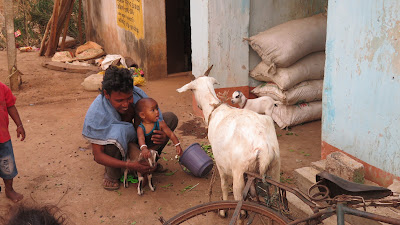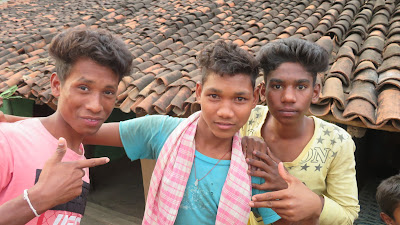The stage at 5:30am.
Leon and his guest house staff.
Euan manoeuvres through the village.
The countryside.
Another local market.
Women of the Dongoria tribe.
A one day old goat and mom.
Three local village boys, looking quite western.
The orphanage school.
Wednesday, April 4th.
Luckily, I went to bed early as Nico went
out for the night’s festival celebrations again and didn’t come back until
four, when he woke me up. I got up and showered and got organized and then
decided to go out to check out the festival at 5:30. There were still lots of
people around and the play was going loud and strong. The part I videoed had
two women slapping another woman around.
I went back to the guest house in case
everyone was ready, but they weren’t. I told Pulak about the violence in the
play and he told me it was a domestic drama, like a Bollywood soap opera. Because
the ‘play’ was still going on, we couldn’t get our truck out and drive through
the crowd. So, we waited. Nico and I took photos of Leon’s employees in their
beautiful sarees. I asked Leon to join in, but he declined. He is an enigma,
and only as friendly as he has to be. There is something odd about him, over
and above the fact that he has run away from his life in Australia to live in
this very remote location where he is isolated from the world.
I went back to the play again to see it at
dawn and got a couple of good shots. Then back again and we all carried our
luggage to the truck and then hung around watching and waiting. The play was
still going on, but the crowd had thinned considerably. Finally, it ended and
we were able to drive out of the village with all eyes staring at us and our
monstrous truck.
Then we commenced a long drive to the town
of Bissamcuttack and another weekly market. The road is full of trucks, one
part was under construction and it was full of twists and turns which made it
hard to pass. At one point we got stuck in a long line of trucks. At first we
thought there was an accident, but it turned out to be a rail crossing. When we
got to the market, Pulak gave us some information about the Dongria, which is
apparently one of the rarest tribes. They live in the hills and come together
once a week at the market to buy, trade and socialize. The women are very
strong in this tribe and run the families. They wear three gold nose rings. We
wandered around for an hour watching the interactions in the market.
Then we continued on in the truck to a town
where we stopped to buy snacks before finally getting to our accommodation about
1:30, in Muniguda, at the New Hope Charitable Trust, a local NGO. As soon as we
got there we were served a typical local thali vegetarian lunch. Then we
checked into our simple, basic rooms. After that I went back to where we ate,
because there was a teacher workshop going on and the group were having the
same lunch we did. I was able to talk to a couple of them about very basic
things. They are here to gain strength in teaching math and language (what else
is new?) and how to keep students from dropping out. They have the same problem
here as I encountered in Ghana. The state trained teachers don’t want to work
in the remote rural villages where they often don’t speak the same language as
the locals. Therefore, the community either has volunteers or hires local
people and then train them to be teachers. When I was talking to one, a group
gathered around. One guy wanted to know my salary. Then they went back to their
workshop. I stayed and organized the material for the blog.
Euan told us about the New Hope Charitable
Trust, which has been run by one local man for about thirty years. Most of his
employees have been there almost as long. It was a local Indian NGO which provided
doctors for diagnosis and treatment of diseases that were afflicting the local
tribes people. They were instrumental in helping with malaria, leprosy and
elephantitis. They gained the trust of the people and undertook different projects
to benefit the community including an orphanage and school, and an old age home
on the property where we were staying. Unfortunately, the government declared
that these diseases were eradicated in India even though that was not the case.
They were greatly reduced but New Hope knew there were still new cases, but
their funding was cut because officially there was no longer a need. However, the
NGO remains active in the community in different ways.
When it got a bit cooler in the late
afternoon, we went for a walk. Pulak led us to another little village where we
got to see the local people and interact with them. It makes all the difference
having a local guide. He told us that because there are so many people in the
country and they are encroaching on habitat, there are conflicts between
wildlife, elephants specifically and people. This area is one of those areas
during harvest time. The elephants are in the hills and can smell fresh
vegetables and come down to help themselves.
We continued walking along a dirt track
through the countryside to another village where we met other people. Pulak
suggested buying some crackers from the local little shop. He picked out a
whole bunch of little packets, not for us but for the children. So, I gave him
100 rupees to pay for it and he gave the bag to the kids. They were delighted
and immediately went to a house where they opened all the packets and counted
them out. Then they distributed them to all the houses. A local man who was up
a sago palm tree, climbed down with a bottle of fluid from the tree for us to
sample. Pulak contends it is great for the constitution.
On the way back at dusk, we stopped at the
New Hope Orphanage and met the teacher, Mr. Jagdish Mishra, who had 11 of his
charges introduce themselves to us. They were a diverse group of kids from
early teens to early thirties, with downs, blindness, autism and mental and
physical handicaps. As always when confronted by this type of experience I felt
uncomfortable. I feel like they are being put on display, or that they are
trying to get money out of my pocket. But, when we left and the kids came up
and hugged us and thanked us and led us to their dormitories to show us where
they sleep, I was touched. And to think about the dedication of this teacher,
who has given up 25 years of his life to work with these kids, is mind
boggling. He lives on site and goes to his village three times a month to see
his wife. Then I thought about how lucky these kids were to be taken care of by
this man and this NGO, and about the thousands of others in this country who
probably get no help what so ever. And about the crap shoot of life, where you
are born and how lucky you are if you are born healthy.

















Guayanese plurinationals as Wayuu indigenous nationalities got soon saints yeah, we're nomadic as Mongols are, as Himalayans ate. We run away, we walk away the merry path, the non change over the doors. Thirsts for change, thirsts for the obvious.
ReplyDeleteAugusto Díaz.